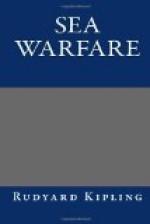SUBMARINE AND ICE-BREAKER
Let us take, almost at random, an episode in the life of H.M. Submarine E9. It is true that she was commanded by Commander Max Horton, but the utter impersonality of the tale makes it as though the boat herself spoke. (Also, never having met or seen any of the gentlemen concerned in the matter, the writer can be impersonal too.) Some time ago, E9 was in the Baltic, in the deeps of winter, where she used to be taken to her hunting grounds by an ice-breaker. Obviously a submarine cannot use her sensitive nose to smash heavy ice with, so the broad-beamed pushing chaperone comes along to see her clear of the thick harbour and shore ice. In the open sea apparently she is left to her own devices. In company of the ice-breaker, then, E9 “proceeded” (neither in the Senior nor the Junior Service does any one officially “go” anywhere) to a “certain position.”
Here—it is not stated in the book, but the Trade knows every aching, single detail of what is left out—she spent a certain time in testing arrangements and apparatus, which may or may not work properly when immersed in a mixture of block-ice and dirty ice-cream in a temperature well towards zero. This is a pleasant job, made the more delightful by the knowledge that if you slip off the superstructure the deadly Baltic chill will stop your heart long before even your heavy clothes can drown you. Hence (and this is not in the book either) the remark of the highly trained sailor-man in these latitudes who, on being told by his superior officer in the execution of his duty to go to Hell, did insubordinately and enviously reply: “D’you think I’d be here if I could?” Whereby he caused the entire personnel, beginning with the Commander, to say “Amen,” or words to that effect. E9 evidently made things work.
Next day she reports: “As circumstances were favourable decided to attempt to bag a destroyer.” Her “certain position” must have been near a well-used destroyer-run, for shortly afterwards she sees three of them, but too far off to attack, and later, as the light is failing, a fourth destroyer towards which she manoeuvres. “Depth-keeping,” she notes, “very difficult owing to heavy swell.” An observation balloon on a gusty day is almost as stable as a submarine “pumping” in a heavy swell, and since the Baltic is shallow, the submarine runs the chance of being let down with a whack on the bottom. None the less, E9 works her way to within 600 yards of the quarry; fires and waits just long enough to be sure that her torpedo is running straight, and that the destroyer is holding her course. Then she “dips to avoid detection.” The rest is deadly simple: “At the correct moment after firing, 45 to 50 seconds, heard the unmistakable noise of torpedo detonating.” Four minutes later she rose and “found destroyer had disappeared.” Then, for reasons probably connected with other destroyers,




